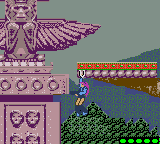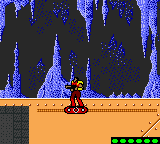Bionic Commando - Elite Forces
System: Game Boy Color
Review written May, 2000
Bionic Commando is unique in two ways that distinguish it from most other sidescrolling platform games and make it worth a look even for people who've played many sidescrollers before. The least discussed in reviews is that it is one of the very few games which can be accurately described as an action/adventure game. The fights in adventure games tend to be trivial, and the number of deaths are dwindling, while action games tend to be mostly straight forward. Bionic Commando has more of a balance.
At the beginning of Bionic Commando you have a very short life meter, but as you kill enemies it grows - it's like gaining experience. After you beat each stage a weapon or item is added to your arsenal, and the feeling of becoming more powerful through the progression of the game is similar to, but subtler, not as pronounced, as in games such as Super Metroid and Castlevania: Symphony of the Night. There's a bit of strategy involved in that you can only take one item from each category into a stage. Usually, though, the choice is foregone. There's not much difference between most of the weapons aside from their strength, so you'll simply take the most powerful weapon into battle (unless you'd like to increase the challenge). Likewise, you'll always take the best armor. You may occasionally take different items, but more often than not you'll take the energy refilling pills. Unlike early Super Mario Bros. or Castlevania games, you don't simply move from left to right, but rather often explore a large area going in all directions. Your first goal in a stage is usually to find a communications room, where you can contact your support and eavesdrop on enemies. This unlocks a door later in the level which you then must find. The stages are connected by a landform map as in Super Mario Bros. 3 (actually, Bionic Commando did this before SMB3, but I assume more people are familiar with SMB3). At times you can choose the order in which you'd like to complete the stages, which adds a small element of nonlinearity to the game. For instance, at the beginning of the game you can move to any of the first 5 stages, in principle. In reality, stage 5 is locked by a key card which you must get in another stage. In any case, it usually makes sense to beat the stages in the suggested order, even if you don't need to. There are also two optional stages in the game which can be unlocked and beaten if you can find them. There is little reward to completing the optional stages other than (of course) fun.
The other way that Bionic Commando is different from most other side scrollers is that you cannot jump. Pressing the B button fires your weapon; pressing the A button fires off a grappling hook. If it attaches to a platform above you, you can hoist yourself up or can begin to swing. The play control is much better than in the NES Bionic Commando. In that game, if your hoist was pulled taut and you then dropped and fired your grappling hook again you would fall too fast for the hook to reattach to the platform. This is not the case in Bionic Commando: Elite Forces. You'll often swing from platform to platform, never touching the ground for long stretches of time. Though other games have adopted this swinging style of game play, such as Super Metroid and Castlevania 4 (in parts), BC:EF's is the most intuitive and fun. One advantage that Bionic Commando has is that firing the grapple when the control pad is in the neutral position makes the grapple move up diagonally, making it easier to hook it to platforms ahead of you and progress when you swing. Though you can not add slack to the line after you've tightened it it hardly matters - if you need to start swinging after tightening the line, you can simply drop and reattach it. Though you might imagine that not being able to jump could cause problems in an intense firefight, this is really not an issue since this game does not play like, for instance, Contra. The majority of soldiers can easily be defeated by ducking and shooting at them - they only shoot when standing. Bionic Commando, however, is not about gunfights. Just as Super Mario Bros. (and its second half, the Lost Levels) is about jumping over obstacles, so is Bionic Commando's core game play based on elaborate swings from ledge to ledge. At times you'll have to do maneuvers such as swing past platforms, then turn in midair and fire your hook at them after you've passed, then swing back, then forward and detach and continue your swing. This may only be part of a multipart climb up a building where one mistake will force you to redo the entire sequence - or at times will kill you. The entire game is not made only of swings, however. There are moving platforms you'll have to hitch rides on, and are also jets of air that will propel you slightly into the air. At times you'll have to even swing with your hook and land on moving platforms, which definitely takes practice.
Though swinging side scrolling stages form the bulk of BC:EF, the game has other features. You can play the game as either a male or a female. Though the manual describes them in the typical stereotypical ways (the female is supposed to be more agile, for example), the game designers were apparently in favor of sexual equality. I can't tell any difference in the way the male and female control at all. Also, on the overhead stages, trucks move back and forth (to continue the analogy with SMB3's map, these are similar to the wandering hammer bros.) When you come in contact with them, you'll fight an overhead stage. In these stages, your grapple hook swings around you and deflects bullets and pushes enemies away. To put it simply, don't use the hook in these stages. There's a bizarre control quirk where however you're moving when you first swing the hook, you'll continue to move in that way as the hook swings no matter what you do with the control pad. All these overhead stages are short (can be finished in less than one minute) and, excluding the hidden, optional over head stages, there are only three of them. However, you'll have to enter them fairly often to stock up on extra lives just as you would have to enter the overhead stages repeatedly in the NES Bionic Commando to stock up on continues (BC:EF has a battery save). Also, the back of BC:EF's box touts a sniper mode. This feels like an afterthought and is hardly a selling point of the game. In a very, very few sidescrolling stages you'll come across crosshairs in the background and a voice will say, "Sniper Mode" - here, the view is through a rifle sight as you try to kill 3 soldiers off in the distance in about 30 seconds . If you succeed you get an item that refills your life. I've never failed. It's only a bonus game, but it's more fun than many other bonus games in recent memory.
The music is fairly good, and at least a couple of tracks are quite memorable. However, there aren't really enough tracks for the number of stages, and most themes will be reused many times. The game also has some digitized voice. The title of the game is read, the name of items you select to take into a stage are read, and a few other words are said in a few parts of the game (such as "Attack!") They sound rather robotic, but considering the futuristic theme of this game this is not a big setback. If the voices in Crystalis will sound as robotic, that would be a bad thing. The graphics are also well-done, particularly the animation. When you enter a stage, your character descends by parachute, collapses when you hit the ground, recovers to his or her feet gracefully, and draws their weapon. This sequence is very well animated. The rest of the game has decent animation as well, particularly the female when swinging from her hook (her ponytail swings as she does). Though at times the backgrounds lack detail, particularly in the city, and though they don't seem as vivid as other Game Boy Color titles, such as R-Type DX, Harvest Moon GBC, or Link's Awakening DX, there are interesting touches. For instance, there are carved stone faces among the ruins in the jungle stages, and hieroglyphics adorn the desert stages. There isn't too much variety in the backgrounds: most are jungles, cities, sewers, or deserts.
The game's weakest point is definitely the boss fights. Many can be beaten simply by firing at them without dodging, and they will die before you do. Of course, you may need to dodge during certain parts of some enemies' attacks, but if you take the rapid fire device, that strategy will allow you to even beat the end boss of the game! Also, the game's learning curve in general is too shallow. The early stages are all easy, but that can be forgiven since their purpose is to accustom you to the controls. However, by the middle of the game you'll be doing some elaborate swings, but they'll all be over a platform, so if you mess up you'll simply have to try again. You won't need to do tricky swings over bottomless pits until very close to the end of the game. By then, it seems like more could have been done with the game's engine to squeeze more challenges out of it. Too many stages are spent for practice. Though the game has 18 stages, one more than Castlevania 3, it's not nearly as hard as Castlevania 3.
There are other gripes, of course, mostly small ones. When you fight reactor bosses their attacks that you must dodge are telegraphed with a beep. If you're playing on a bus or airplane you may need to have the volume off. It'd have been better to have this announced with a flash on the screen or something. Occasionally you'll have to make some blind swings of faith, but those aren't too big of a problem. Since the game is 2D, you can only swing in one direction or the other to find your next toe-hold, and bottomless pits are marked. In the end, though, Bionic Commando: Elite Forces is a unique action game that is well-suited to play on the Game Boy Color (unlike, say, R-Type DX) and is worth a look for action fans.



3 Stars


